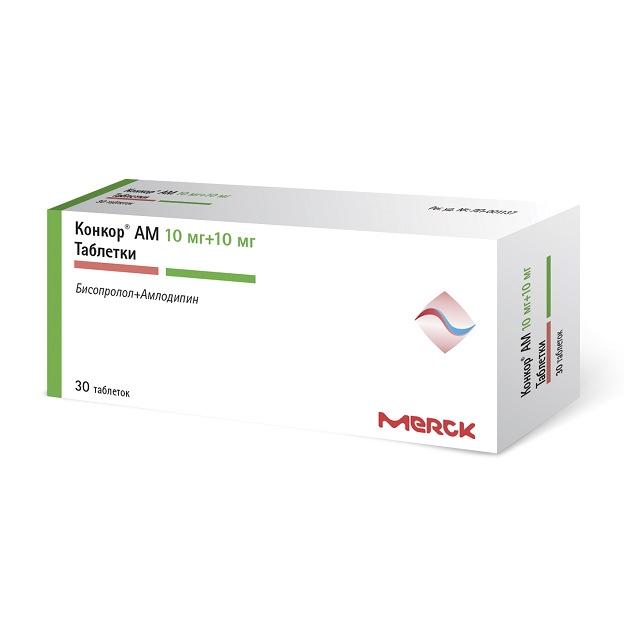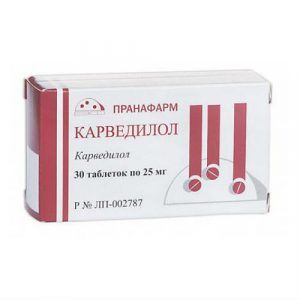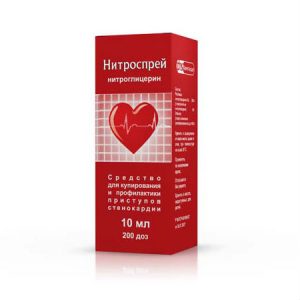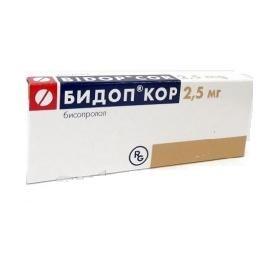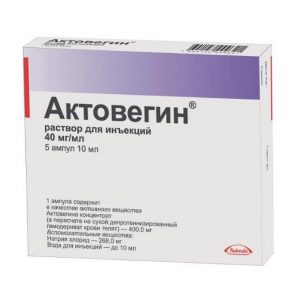Description
Release form
Tablets.
Packing
30 pcs.
Pharmacological action
Concor AM – combined antihypertensive drug. It has pronounced antihypertensive and antianginal effects due to the complementary action of two active substances: slow calcium channel blocker (BMCC) – amlodipine and selective beta1-blocker – bisoprolol.
Amlodipine: Amlodipine blocks calcium channels, reduces the transmembrane transition of calcium ions to the cell (more to the smooth muscle cells of blood vessels than to cardiomyocytes).
The antihypertensive effect of amlodipine is due to the direct relaxing effect on vascular smooth muscle cells, leading to lower peripheral vascular resistance.
The mechanism of antianginal action is not fully understood, perhaps it is associated with the following two effects.
1. The expansion of peripheral arterioles reduces OPSS, ie afterload. Since amlodipine does not cause reflex tachycardia, myocardial energy and oxygen consumption is reduced.
2. The expansion of the large coronary arteries and coronary arterioles improves the oxygen supply of both normal and ischemic myocardial zones. Thanks to these effects, myocardial oxygen supply improves, even with spasm of the coronary arteries (Prinzmetal angina pectoris or unstable angina pectoris). In patients with arterial hypertension, the drug is taken 1 time / day. causes a clinically significant decrease in blood pressure in the supine position and standing throughout the entire 24-hour interval between doses of the drug. Due to the slow development of the antihypertensive effect of amlodipine, it does not cause acute arterial hypotension.
In patients with angina pectoris, the drug is taken 1 time / day. increases the total time of physical activity, the time before the development of an attack of angina pectoris, as well as the time to significantly reduce the ST interval, and also reduces the frequency of attacks of angina pectoris and the need for sublingual administration of nitroglycerin.
No adverse effects of amlodipine on the exchange of plasma lipids, blood glucose and uric acid of blood serum.
Bisoprolol: Bisoprolol is a selective beta1-blocker, without its own sympathomimetic activity, does not have a membrane-stabilizing effect.
It has only a slight affinity for the 2-adrenergic receptors of the smooth muscles of the bronchi and blood vessels, as well as for the 2-adrenergic receptors involved in the regulation of metabolism. Consequently, bisoprolol as a whole does not affect airway resistance and metabolic processes in which β2-adrenergic receptors are involved.
The selective effect of the drug on beta1-adrenergic receptors remains outside the therapeutic range.
Bisoprolol does not have a pronounced negative inotropic effect.
The maximum effect of the drug is achieved 3-4 hours after ingestion. Even with the appointment of bisoprolol 1 time / day. its therapeutic effect persists for 24 hours thanks to 10-12 hours of T1 / 2 from blood plasma. As a rule, the maximum antihypertensive effect is achieved 2 weeks after the start of treatment.
Bisoprolol reduces the activity of the sympathoadrenal system (CAS) by blocking 1-adrenoreceptors of the heart.
With a single oral administration in patients with coronary heart disease without signs of chronic heart failure, bisoprolol reduces heart rate, reduces stroke volume of the heart and, as a result, reduces the ejection fraction and myocardial oxygen demand. With prolonged therapy, initially elevated OPSS decreases. A decrease in plasma renin activity is considered as one of the components of the hypotensive effect of beta-blockers.
Indications
Arterial hypertension CHD (angina pectoris) chronic heart failure.
Contraindications
amlodipine:
– unstable angina (with the exception of Prinzmetal angina)
– acute myocardial infarction (within the first 28 days)
– clinically significant aortic stenosis.
Bisoprolol: – acute heart failure or chronic heart failure in the stage of decompensation, requiring inotropic therapy
– AV block II and III degree, without pacemaker
– CVD
– sinoatrial blockade
– severe / less heart disease. )
– severe forms of bronchial asthma or COPD
– severe peripheral arterial circulatory disorders or Raynaud’s syndrome
– pheochromocytoma (without the simultaneous use of alpha-blockers)
– metabol Acidosis
Amlodipine / Bisoprolol Combination: – severe arterial hypotension (systolic blood pressure less than 100 mm Hg)
– shock (including cardiogenic)
– age under 18 years (efficacy and safety have not been established)
– hypersensitivity to amlodipine, other derivatives of dihydropyridine, bisoprolol and / or any of the excipients.
Precautions: chronic heart failure (including non-ischemic etiology of NYHA class III-IV functional class), liver failure, renal failure, hyperthyroidism, diabetes mellitus with significant fluctuations in blood glucose concentration, grade I AV block, angina pectoris Prinzmetal, peripheral arterial occlusion diseases, psoriasis (including history), starvation (strict diet), pheochromocytoma (with the simultaneous use of alpha-blockers), bronchial asthma and COPD, concomitant desensitizing therapy, general anesthesia, old age, hypotension, type 1 diabetes, aortic stenosis, mitral stenosis, acute myocardial infarction (after the first 28 days).
Use during pregnancy and lactation
Should not be prescribed Concor during pregnancy and lactation (breastfeeding) due to the lack of clinical experience with the drug in this category of patients.
In exceptional cases of Concor use during pregnancy, treatment should be discontinued 72 hours before the expected date of delivery due to the possibility of bradycardia, hypoglycemia and respiratory depression in the newborn. If drug withdrawal is not possible, then after delivery, the newborn should be closely monitored. Symptoms of hypoglycemia can be expected during the first 3 days.
Special instructions
Amlodipine: Patients with heart failure should take amlodipine with caution. In patients with heart failure stage III-IV according to NYHA classification, amlodipine increases the risk of pulmonary edema, which is not associated with an exacerbation of the symptoms of chronic heart failure.
Bisoprolol: Discontinuation of bisoprolol treatment should not be sudden, especially in patients with coronary heart disease, unless there is a clear indication for drug withdrawal. Sudden withdrawal of bisoprolol can lead to a temporary deterioration of cardiac pathology. Bisoprolol should be prescribed with extreme caution to patients with arterial hypertension or angina pectoris, in combination with heart failure. As with other beta-blockers, bisoprolol can cause increased sensitivity to allergens and increased anaphylactic reactions, so caution should be exercised when desensitizing therapy is performed at the same time. The use of adrenaline may not always give the expected therapeutic effect.
When using bisoprolol, the symptoms of hyperthyroidism may mask.
In patients with pheochromocytoma, bisoprolol should be prescribed only after blockade of -adrenergic receptors.
Before general anesthesia is performed, the anesthetist must be informed that the patient is taking beta-blockers. If beta-blocker must be discontinued before surgery, this should be done gradually and completed approximately 48 hours before anesthesia.
In bronchial asthma or COPD, the simultaneous use of bronchodilating agents is indicated. In patients with bronchial asthma, an increase in airway resistance is possible, which requires a higher dose of beta2-adrenergic agonists.
Influence on the ability to drive vehicles and control mechanisms
During treatment with Concor AM, care must be taken in driving vehicles and working with technically complex mechanisms.
Composition of
1 tablet contains bisoprolol 10 mg and amlodipine 10 mg
Dosing and Administration
Dosage regimen set individually.
Side effects
Determination of the frequency of adverse reactions observed with separate use of amlodipine and bisoprolol: very often (? 1/10), often (? 1/100 –
Amlodipine: from the hemopoietic system: very rarely – leukopenia, thrombocytopenia.
From the side of metabolism: very rarely – hyperglycemia.
From the psyche: rarely – insomnia, mood changes (including anxiety), depression rarely – confusion.
From the nervous system: often – headache, dizziness, drowsiness (especially at the beginning it is treated i) rare – syncope, hypoesthesia, paraesthesia, dysgeusia, tremor very rarely – muscle hypertension, peripheral neuropathy
part of the vision: rarely – visual disturbances (including diplopia)
the part of the organ of hearing and labyrinth disorders.:. infrequently – tinnitus.
From the digestive system: often – nausea, abdominal pain infrequently – change in bowel movement (including constipation or diarrhea), dyspepsia, dry oral mucosa is very rare – gastritis, gingival hyperplasia, pancreatitis.
From the liver and biliary tract: very rarely – hepatitis (in most cases with cholestasis), jaundice (in most cases with cholestasis).
From the cardiovascular system: often – palpitations, inflows to the face infrequently – a marked decrease in blood pressure is very rare – myocardial infarction, arrhythmia (bradycardia, ventricular tachycardia, atrial fibrillation), vasculitis.
From the respiratory system: infrequently – shortness of breath, rhinitis is very rare – cough.
From the urinary system: infrequently – pollakiuria, painful urination, nocturia.
From the genitals and mammary gland: infrequently – impotence, gynecomastia.
From the musculoskeletal system: often – swelling of the ankles infrequently – arthralgia, myalgia, muscle cramps, back pain.
Allergic reactions: very rarely – angioedema, urticaria, Quincke edema.
From the skin and subcutaneous tissues: infrequently – alopecia, purpura, skin discoloration, increased sweating, itching, rash, exanthema very rarely – erythema multiforme, exfoliative dermatitis, Stevens-Johnson syndrome, photosensitivity.
General disorders: often – peripheral edema, increased fatigue infrequently – chest pain, asthenia, pain, general malaise.
Laboratory and instrumental data: infrequently – weight gain, weight loss is very rare – an increase in the activity of liver enzymes in most cases with cholestasis.
Bisoprolol: On the part of the metabolism: rarely – increased concentration of triglycerides.
From the psyche: infrequently – depression is rare – hallucinations, nightmares.
From the side of the nervous system: often – headache *, dizziness * infrequently – insomnia rarely – fainting.
From the side of the organ of vision: rarely – reduction in lacrimation (should be taken into account when wearing contact lenses) very rarely – conjunctivitis.
On the part of the hearing organ and labyrinth disorders: rarely – hearing impairment.
From the cardiovascular system: often – a feeling of cooling or numbness in the limbs, a marked decrease in blood pressure infrequently – a violation of AV conduction, bradycardia, aggravation of symptoms of the course of chronic heart failure, orthostatic hypotension.
From the respiratory system: infrequently – bronchospasm in patients with bronchial asthma or a history of airway obstruction rarely – allergic rhinitis.
From the digestive system: often – nausea, vomiting, diarrhea, constipation.
From the liver and biliary tract: rarely – hepatitis.
On the part of the skin and subcutaneous integument: rarely – hypersensitivity reactions, such as skin itching, rash, redness of the skin very rarely – alopecia. Beta-blockers can exacerbate the symptoms of psoriasis or cause a psoriasis-like rash.
From the musculoskeletal system: infrequently – muscle weakness, muscle cramps.
From the genitals and mammary gland: rarely – impotence.
General disorders: often – fatigue * infrequently – exhaustion *.
Laboratory and instrumental data: rarely – increased activity of hepatic transaminases in the blood (ACT and ALT).
* Especially often, these symptoms appear at the beginning of treatment. Typically, these phenomena are mild and go away, usually within 1-2 weeks after the start of treatment.
Drug interaction
Amlodipine: Concomitant use of amlodipine with thiazide diuretics, beta-blockers, long-acting nitrates, sublingual nitroglycerin preparations, nonsteroidal anti-inflammatory drugs (NSAIDs), antibiotics, and hypoglycemic agents for oral administration are considered safe.
Caution is advised to use amlodipine concomitantly with CYP3A4 inhibitors. Although adverse events related to such an interaction were not reported.
Concomitant use with CYP3A4 inhibitors (including rifampicin, St. John’s wort perforated) can lead to a decrease in the concentration of amlodipine in blood plasma. With caution, amlodipine should be used concurrently with CYP3A4 inducers.
Grapefruit juice, cimetidine, aluminum / magnesium (as part of antacids) and sildenafil do not affect the pharmacokinetics of amlodipine.
Amlodipine may enhance the antihypertensive effect of other antihypertensive drugs.
Amlodipine does not affect the pharmacokinetics of atorvastatin, digoxin, ethanol (drinks containing alcohol), warfarin or cyclosporine.
Amlodipine has no effect on laboratory parameters.
Bisoprolol: Recommended combinations: BMKK type verapamil and, to a lesser extent, diltiazem, while using bisoprolol can lead to a decrease in myocardial contractility, a marked decrease in blood pressure and impaired AV conductivity. In particular, the intravenous administration of verapamil to patients taking beta-blockers can lead to severe arterial hypotension and AV block.
Centrally acting antihypertensive drugs (such as clonidine, methyldopa, moxonidine, rilmenidine) when used together with bisoprolol can lead to a reduction in heart rate and a decrease in cardiac output, as well as to vasodilation due to a decrease in central sympathetic tone. Abrupt cancellation especially before the abolition of beta-blockers may increase the risk of ricochet arterial hypertension.
Combinations requiring caution: BMCC derivatives of dihydropyridine (eg, nifedipine) when used concomitantly with bisoprolol may increase the risk of developing hypotension. In patients with chronic heart failure, the risk of a subsequent deterioration in the contractile function of the heart cannot be ruled out.
Class I antiarrhythmic drugs (e.g., quinidine, disopyramide, lidocaine, phenytoin, flecainide, propafenone), while used with bisoprolol, can reduce AV conductivity and myocardial contractility. Class III antiarrhythmic drugs (for example, amiodarone) can increase the violation of AV conduction.
Parasympathomimetics with simultaneous use with bisoprolol can increase the violation of AV conduction and increase the risk of developing bradycardia.
Topical beta-blockers (for example, eye drops for glaucoma) can enhance the systemic effects of bisoprolol (lowering blood pressure, lowering heart rate).
The hypoglycemic effect of insulin or hypoglycemic agents for oral administration may be enhanced. Signs of hypoglycemia – in particular tachycardia – may be masked. Such interactions are more likely when using non-selective beta-blockers.
General anesthesia medications can weaken reflex tachycardia and increase the risk of hypotension.
Cardiac glycosides, when used concomitantly with bisoprolol, can lead to an increase in the duration of the pulse and to the development of bradycardia.
NSAIDs may decrease the antihypertensive effect of bisoprolol.
The simultaneous use of bisoprolol with beta-adrenergic agonists (for example, isoprenaline, dobutamine) can lead to a decrease in the effect of both drugs.
The combination of bisoprolol with adrenergic agonists affecting – and – adrenergic receptors (e.g., norepinephrine, epinephrine) can enhance the vasoconstrictor effects of these agents that occur with the participation of -adrenoreceptors, leading to an increase in blood pressure. Such interactions are more likely when using non-selective beta-blockers.
Antihypertensive drugs, as well as other drugs with a possible antihypertensive effect (for example, tricyclic antidepressants, barbiturates, phenothiazines) may enhance the antihypertensive effect of bisoprolol.
Combinations to consider: Mefloquine when used concomitantly with bisoprolol may increase the risk of developing bradycardia.
MAO inhibitors (with the exception of MAO B inhibitors) may enhance the antihypertensive effect of beta-blockers. Simultaneous use can also lead to the development of a hypertensive crisis.
Rifampicin slightly shortens T1 / 2 of bisoprolol. As a rule, dose adjustment is not required.
Ergotamine derivatives when used concomitantly with bisoprolol increase the risk of peripheral circulation disturbance.
Overdose
Amlodipine.
Symptoms: pronounced decrease in blood pressure with possible development of reflex tachycardia and excessive peripheral vasodilation (risk of developing severe and persistent arterial hypotension, including with the development of shock and death).
Treatment: gastric lavage, appointment of activated charcoal, maintenance of cardiovascular function, control of cardiac and pulmonary function, elevated limb position, control of circulating blood volume and diuresis.
Intensive symptomatic therapy.
To restore the tone of the vessels – the use of vasoconstrictor drugs (in the absence of contraindications to their use).
To eliminate the effects of calcium channel blockade, intravenous administration of calcium gluconate.
Hemodialysis is not effective.
Bisoprolol.
Symptoms: AV-blockade, pronounced bradycardia, bronchospasm, marked BP, acute heart failure, hypoglycemia.
The sensitivity to a single high dose of bisoprolol varies greatly among individual patients, and patients with CHF are likely to have high sensitivity.
Treatment: in the event of an overdose, first of all, it is necessary to discontinue the drug and start supportive symptomatic therapy.
With severe bradycardia.
Intravenous administration of atropine. If the effect is insufficient, it is possible to enter with caution the positive chronotropic action with caution. Occasional staging of an artificial rhythm driver may be required.
When a marked decrease in blood pressure.
Intravenous administration of plasma replacement solutions and vasopressor drugs. Glucagon intravenous administration may also be indicated.
For AV blockade.
Patients should be constantly monitored and treated with beta-epinephrine such as epinephrine. If necessary – production of an artificial rhythm driver.
When exacerbation of the course of CHF.
Intravenous administration of diuretics, positive inotropic drugs, and vasodilators.
In bronchospasm
Purpose of bronchodilators, including beta2-adrenomimetics and / or aminophylline.
In hypoglycemia.
Intravenous administration of dextrose (glucose).
Storage conditions
Keep out of the reach and sight of children, at temperatures not exceeding 30 ° C.
Shelf life
3 years. Do not use after expiration date.
Deystvuyushtee substance
Amlodipine, bisoprolol
drugstore conditions
drugstore
dosage form
tablets
Possible product names
CONCOR AM 0.01 + 0.01 N30 TABLE
Concor AM 10mg + 10mg Tab. X30
CONCOR AM TAB. 10MG + 10MG No. 30
CONCOR AM TABLE. 10MG + 10MG N30
Concor AM tab. 10mg + 10mg N30 Hungary
Merck KGaA, Russia
